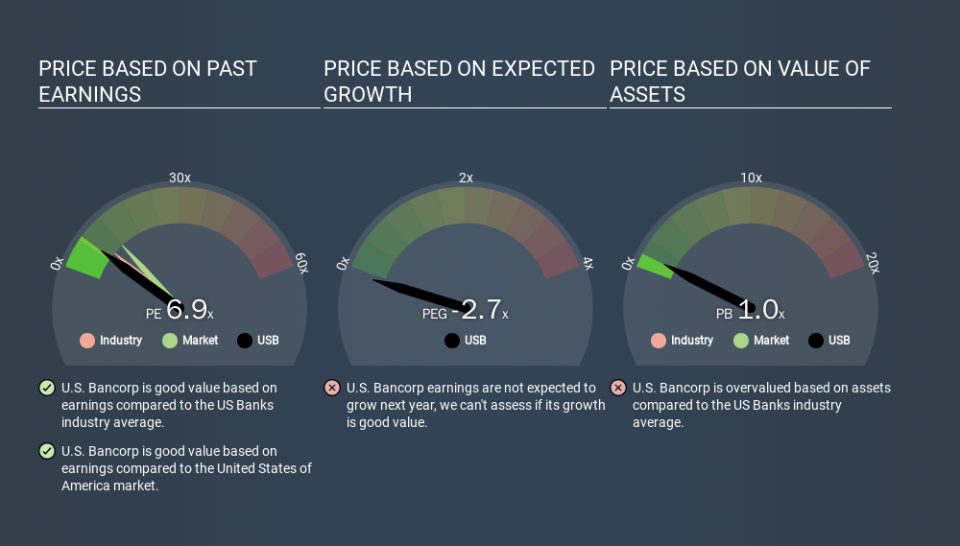A Sliding Share Price Has Us Looking At U.S. Bancorp's (NYSE:USB) P/E Ratio

Unfortunately for some shareholders, the U.S. Bancorp (NYSE:USB) share price has dived 47% in the last thirty days. That drop has capped off a tough year for shareholders, with the share price down 40% in that time.
Assuming nothing else has changed, a lower share price makes a stock more attractive to potential buyers. In the long term, share prices tend to follow earnings per share, but in the short term prices bounce around in response to short term factors (which are not always obvious). The implication here is that long term investors have an opportunity when expectations of a company are too low. One way to gauge market expectations of a stock is to look at its Price to Earnings Ratio (PE Ratio). Investors have optimistic expectations of companies with higher P/E ratios, compared to companies with lower P/E ratios.
See our latest analysis for U.S. Bancorp
How Does U.S. Bancorp's P/E Ratio Compare To Its Peers?
U.S. Bancorp's P/E of 6.95 indicates relatively low sentiment towards the stock. If you look at the image below, you can see U.S. Bancorp has a lower P/E than the average (8.3) in the banks industry classification.
Its relatively low P/E ratio indicates that U.S. Bancorp shareholders think it will struggle to do as well as other companies in its industry classification. While current expectations are low, the stock could be undervalued if the situation is better than the market assumes. It is arguably worth checking if insiders are buying shares, because that might imply they believe the stock is undervalued.
How Growth Rates Impact P/E Ratios
Probably the most important factor in determining what P/E a company trades on is the earnings growth. That's because companies that grow earnings per share quickly will rapidly increase the 'E' in the equation. And in that case, the P/E ratio itself will drop rather quickly. So while a stock may look expensive based on past earnings, it could be cheap based on future earnings.
U.S. Bancorp's earnings per share were pretty steady over the last year. But it has grown its earnings per share by 6.1% per year over the last five years.
Don't Forget: The P/E Does Not Account For Debt or Bank Deposits
The 'Price' in P/E reflects the market capitalization of the company. That means it doesn't take debt or cash into account. Theoretically, a business can improve its earnings (and produce a lower P/E in the future) by investing in growth. That means taking on debt (or spending its cash).
Such expenditure might be good or bad, in the long term, but the point here is that the balance sheet is not reflected by this ratio.
How Does U.S. Bancorp's Debt Impact Its P/E Ratio?
U.S. Bancorp's net debt is 88% of its market cap. If you want to compare its P/E ratio to other companies, you should absolutely keep in mind it has significant borrowings.
The Verdict On U.S. Bancorp's P/E Ratio
U.S. Bancorp trades on a P/E ratio of 6.9, which is below the US market average of 11.5. The meaningful debt load is probably contributing to low expectations, even though it has improved earnings recently. Given U.S. Bancorp's P/E ratio has declined from 13.1 to 6.9 in the last month, we know for sure that the market is more worried about the business today, than it was back then. For those who prefer invest in growth, this stock apparently offers limited promise, but the deep value investors may find the pessimism around this stock enticing.
When the market is wrong about a stock, it gives savvy investors an opportunity. If the reality for a company is not as bad as the P/E ratio indicates, then the share price should increase as the market realizes this. So this free report on the analyst consensus forecasts could help you make a master move on this stock.
Of course, you might find a fantastic investment by looking at a few good candidates. So take a peek at this free list of companies with modest (or no) debt, trading on a P/E below 20.
If you spot an error that warrants correction, please contact the editor at editorial-team@simplywallst.com. This article by Simply Wall St is general in nature. It does not constitute a recommendation to buy or sell any stock, and does not take account of your objectives, or your financial situation. Simply Wall St has no position in the stocks mentioned.
We aim to bring you long-term focused research analysis driven by fundamental data. Note that our analysis may not factor in the latest price-sensitive company announcements or qualitative material. Thank you for reading.

 Yahoo Finance
Yahoo Finance 
